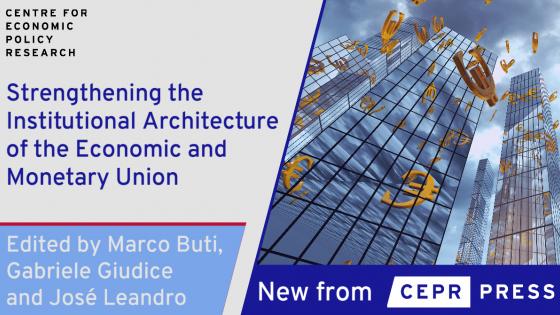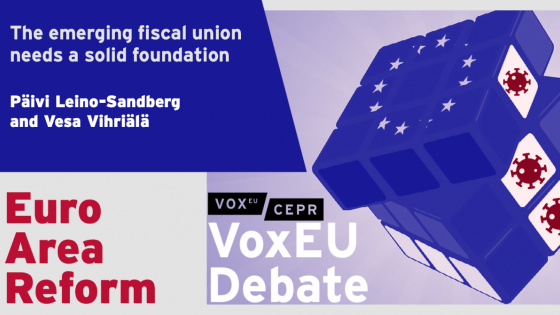Following years of sustained growth, policymakers in Europe – and beyond – have been unexpectedly confronted with the largest health, economic and social challenges since WWII, threatening the stability of the EU and its Economic and Monetary Union (EMU). The crisis generated by the Covid-19 pandemic has required rapid and strong action (Baldwin and Weder di Mauro 2020). It also entails key choices, including on how the EU could help mitigate the impact of Covid-19, foster the economic recovery and support the double green and digital transitions (Bénassy-Quéré and Weder di Mauro 2020).
In September 2019, before the crisis struck, the Directorate General for Economy and Finance of the European Commission organised a workshop on strengthening the institutional architecture of the EMU. A new eBook presents the main ideas discussed in the workshop (Buti et al. 2020). The workshop took stock of the debate on key challenges and the future of EMU’s institutional architecture and sketched out the directions in which the reforms could go. It dealt more in depth with two of the ideas debated in the public sphere at the time: that of a euro area treasury and of a European Minister or High Representative for Economy and Finance. The discussions which took place at that time are still relevant and the proceedings are presented here.
Download Strengthening the Institutional Architecture of the Economic and Monetary Union here.
The weaknesses and solutions discussed in the workshop are still relevant in the economic context reshaped by the Covid-19 crisis. The crisis has shed a light on an incomplete institutional architecture of the EMU and revealed that public opinion expects the EU to deliver in emergency situations. Steps taken in response to the current crisis could bring progress with the EMU deepening agenda. As containment measures are gradually lifted, there is a need to complement national action to rapidly bring those who lost their jobs back into employment, minimise scars from a prolonged shortfall in investment and compensate for the differences in the policy space among Member States. This is why the Commission has proposed a recovery instrument, called Next Generation EU, to top up the multiannual EU budget. This new package is firmly built on the community method, with the EU budget as the main vehicle for providing funds to citizens, firms and Member States. It envisages sizeable grants and loans to Member States to carry out reforms and investment to be defined in national annual plans to be agreed with the Commission. This eBook contributes to the reflection to identify those reforms that, beyond addressing the more immediate needs, can deliver sustainable progress on the institutional set-up of EMU.
Part I of this eBook provides an overview of possible solutions for addressing weaknesses in the EMU institutional architecture. While it may still seem difficult to many, the moment seems propitious for striking grand institutional bargain on EMU, according to Henrik Enderlein. To do so, the debate should consider, along the immediate steps to rebound from the lockdown, other equally important areas – investment to face climate change and support digitalisation; completing the Single Market, including for capital; and the international role of the euro – that can also contribute to EMU stability, but in a different way. Among the areas which deserve attention, Stefano Micossi includes the internal market, the coordination of wage policies and the surveillance of macroeconomic imbalance. Without acting in such a broader perspective, important spillovers across countries would dampen growth. Excessive savings in Germany mean that the euro area’s anchor economy exports ‘lowflation’ to other euro area Member States. Wage coordination between the euro area’s economies, a budget that would transform excessive savings into investment, a more effective implementation of the Macroeconomic Imbalances Procedure, and achieving the internal market for services would avoid imbalances and revive growth in the EMU. Tuomas Saarenheimo cautions against jumping too far with some institutional reforms in the absence of many fundamental preconditions in the EU. Without them, the European elections cannot become an effective channel for democratic accountability. This aspect is especially relevant in the debate on EMU deepening, because the latter increasingly involves decisions on public funds, which should and will get politicised, one way or another.
Part II asks whether – and for what purpose – a euro area treasury could be part of a revamped institutional architecture. Niels Thygesen provides a longer-term perspective on the reasons why a debate on a treasury did not really take off in the 1970s (when first steps towards policy coordination were discussed in the Werner and MacDougall reports), in the following decade when the basis for the EMU was established, or after the eruption of the financial crisis. This was due to the focus on centralising monetary policy, the resistance to even a limited transfer of fiscal sovereignty, and the initial beliefs that stabilisation in the EMU would be taken care of by joint monetary policy and by national automatic stabilisers, so coordination of fiscal policies would be sufficient. However, the combination of tasks that have now accumulated – comprising potential revisions of fiscal governance, more or less conditional lending to governments, and responsibility for financial stability – is creating a new occasion to reconsider the case for an EMU Treasury. Hans-Joachim Klöckers and Sander Tordoir present possible functions of a euro area treasury and desirable principles on which it could be built, using as a possible benchmark the responsibilities of treasuries in existing federations (the US and Germany). Joerg Bibow argues that a treasury could be there to manage a euro area budget, which would debt-finance public investment. This would break the ‘bank–sovereign doom loop’, raise the euro area’s capacity to withstand shocks and provide the missing common safe asset without mutualising existing debts. Finally, while Lucas Guttenberg considers that the main problem for the euro area is that it still lacks a common fiscal policy, he is less convinced by the establishment of a new euro area treasury, both because he sees it as unnecessary (as current institutions can play that role) and because he is wary of assigning the handling of a common fiscal policy to technocrats operating within an intergovernmental setting.
Part III raises the question of whether the time is ripe for a European Minister of/High Representative for Economy and Finance. René Repasi identifies a democratic accountability gap in EMU and finds that a European Minister, as proposed by the Commission in 2017, would improve the flow of information and streamline the political behaviour of the main actors in EMU, but would not give the European Parliament new instruments for accountability. Federico Fabbrini considers that any new reform should be primarily conceived in light of the constitutional principle of good governance, meaning that institutions should be assigned specific functions and should respect the principle of separation of powers. Finally, Daniel Gros proposes developing the external dimension of the EMU’s institutional architecture, moving to unified euro area representation at the IMF assured by the European Stability Mechanism. Such a solution would require an amendment to the ESM Treaty, but not necessarily to the IMF’s Articles of Agreement.
References
Baldwin, R and B Weder di Mauro (eds) (2020), Mitigating the COVID Economic Crisis: Act Fast and Do Whatever It Takes, a VoxEU.org eBook, CEPR Press.
Bénassy-Quéré, A and B Weder di Mauro (eds) (2020), Europe in the Time of Covid-19, a VoxEU.org eBook, CEPR Press.
Buti, M, G Giudice and J Leandro (eds) (2020), Strengthening the Institutional Architecture of the Economic and Monetary Union, a VoxEU.org eBook, CEPR Press.






